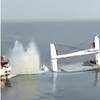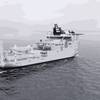Navy Lab Engineers Honored
Recently, he developed technology for suppressing tip vortex cavitation inception by unique shaping of the propeller blade tip geometry. This, along with the new blade sections, has been proven at sea on USS ARLEIGH BURKE (DDG 51) Class destroyers. He recently led a program with the Netherlands, developing advanced propeller tip geometries to suppress tip vortex cavitation, which culminated with a full-scale demonstration on a Royal Netherlands Navy ship.
Throughout much of his career, he has been investigating propulsor hydrodynamic characteristics using Laser Doppler Velocimetry (LDV) and other advanced measurement techniques. Along with his leadership of other engineers in conducting such sophisticated experiments, he also carries out his own experimental research. Recent research efforts include specialized USS VIRGINIA (SSN 774) Class propulsor dynamometry, LDV propulsor flow measurements, and propulsor circulation control. With a background in both steady and unsteady propeller hydrodynamics and specialized experimental techniques, Jessup guides his directorate on surface ship and submarine experimental programs. Jessup was the first to explore the detailed physics of three-dimensional boundary layers on rotating propeller blades, further enhancing the use of LDV. His publication at the 15th Office of Naval Research Symposium on Naval Hydrodynamics in 1984 established the worldwide standard for applying this technology and his 1989 Ph.D. dissertation is referenced worldwide. His many accomplishments have had a profound effect on understanding scaling of propulsor performance and predicting off-design performance. Using the new understanding of viscous flow over rotating propellers, he developed a database now used by the international towing tank community for validating new software for viscous flow calculations. As a matter of fact, he has inspired researchers and propulsor designers around the world to follow his lead. NSWCCD Carderock Division leads the world in developing and using non-intrusive LDV and other Laser Imaging Velocimetry techniques.
Dr. Yuan-Ning Liu, a submarine signatures expert, has been named Senior Research Scientist in Computational Structural Acoustics for the United States Navy. He is well known for his accomplishments making U.S. submarines the quietest in the world, serves on the senior staff of the Signatures Directorate of the Naval Surface Warfare Center's Carderock Division in Bethesda. Working in Navy submarine silencing programs, he made significant contributions in understanding low frequency radiation for both narrowband and broadband signatures and in target strength reduction. (Target strength involves making a submarine more difficult to detect.) To that end, Dr. Liu successfully developed damping of lightweight structures associated with submerged vessels.











